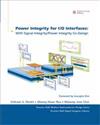| FindBook |
有 3 項符合
POWER INTEGRITY FOR I/O INTERFACES:WITH SIGNAL INTEGRITY / POWER INTEGRITY CO-DESIGN的圖書 |
 |
POWER INTEGRITY FOR I/O INTERFACES: WITH SIGNAL INTEGRITY / POWER INTEGRITY CO-DESIGN 作者:PANDIT 出版社:全華圖書股份有限公司 出版日期:2010-10-13 語言:繁體書 |
| 圖書選購 |
| 型式 | 價格 | 供應商 | 所屬目錄 | $ 1274 |
應用科學 |
$ 1274 |
高等教育 |
$ 1300 |
專業工程學 |
|---|
| 圖書館借閱 |
| 國家圖書館 | 全國圖書書目資訊網 | 國立公共資訊圖書館 | 電子書服務平台 | MetaCat 跨館整合查詢 |
| 臺北市立圖書館 | 新北市立圖書館 | 基隆市公共圖書館 | 桃園市立圖書館 | 新竹縣公共圖書館 |
| 苗栗縣立圖書館 | 臺中市立圖書館 | 彰化縣公共圖書館 | 南投縣文化局 | 雲林縣公共圖書館 |
| 嘉義縣圖書館 | 臺南市立圖書館 | 高雄市立圖書館 | 屏東縣公共圖書館 | 宜蘭縣公共圖書館 |
| 花蓮縣文化局 | 臺東縣文化處 |
|
|
圖書介紹 - 資料來源:博客來 評分:
圖書名稱:POWER INTEGRITY FOR I/O INTERFACES:WITH SIGNAL INTEGRITY / POWER INTEGRITY CO-DESIGN
內容簡介
In this book, three industry experts introduce state-of-the-art power integrity design techniques for today’s most advanced digital systems, with real-life, system-level examples. They introduce a powerful approach to unifying power and signal integrity design that can identify signal impediments earlier, reducing cost and improving reliability.After introducing high-speed, single-ended and differential I/O interfaces, the authors describe on-chip, package, and PCB power distribution networks (PDNs) and signal networks, carefully reviewing their interactions. Next, they walk through end-to-end PDN and signal network design in frequency domain, addressing crucial parameters such as self and transfer impedance. They thoroughly address modeling and characterization of on-chip components of PDNs and signal networks, evaluation of power-to-signal coupling coefficients, analysis of Simultaneous Switching Output (SSO) noise, and many other topics.
目錄
Foreword by Joungho Kim Preface About the Authors
Ch1: Introduction
Ch2: I/O Interfaces
Ch3: Electromagnetic Effects
Ch4: System Interconnects
Ch5: Frequency Domain Analysis
Ch6: Time Domain Analysis
Ch7: Signal/Power Integrity Interactions
Ch8: Signal/Power Integrity Co-Analysis
Ch9: Measurement Techniques Index
Ch1: Introduction
Ch2: I/O Interfaces
Ch3: Electromagnetic Effects
Ch4: System Interconnects
Ch5: Frequency Domain Analysis
Ch6: Time Domain Analysis
Ch7: Signal/Power Integrity Interactions
Ch8: Signal/Power Integrity Co-Analysis
Ch9: Measurement Techniques Index
|








